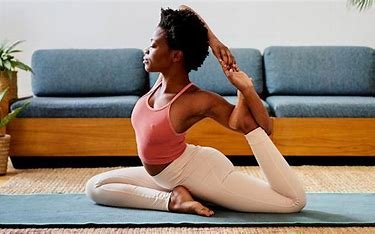Yoga is an excellent practice for improving both flexibility and strength, and it does so in a holistic way by combining physical movement, breath control, and mental focus.

1. Improving Flexibility:
- Stretching muscles and tendons: Yoga poses (asanas) often involve deep stretches that help to lengthen muscles and tendons. Regular practice gradually improves the elasticity of these tissues, leading to increased flexibility over time.
- Dynamic stretching: Many yoga poses involve dynamic movements, which means muscles are stretched and then contracted, improving both flexibility and joint mobility.
- Targeting different muscle groups: Yoga targets a wide range of muscle groups, from large muscle groups like the hamstrings and quadriceps to smaller muscles like those in the hips and back, helping to balance flexibility across the body.
- Increased range of motion: As you practice, your body becomes accustomed to more expansive movements, leading to a wider range of motion in your joints and muscles.
2. Building Strength:
- Bodyweight exercises: Yoga poses require you to lift and hold your own body weight in different positions. For example, poses like plank, downward dog, and warrior builds strength in the core, arms, legs, and back.
- Engaging muscle groups: While holding yoga poses, multiple muscle groups must engage simultaneously. This leads to strength building in areas such as the core (for balance and stability), arms, legs, and back.
- Holding poses for extended periods: In many yoga styles (such as Hatha or Power Yoga), practitioners are asked to hold poses for a longer duration. This sustained muscle engagement promotes muscle endurance and builds strength.
- Mind-muscle connection: Yoga encourages you to focus on your body’s movements, which helps improve control over muscles and enhances strength over time.
3. Balance of Flexibility and Strength:
Yoga is unique in how it strikes a balance between flexibility and strength. For example, some poses (like downward dog or cobra) require both flexibility in the muscles and strength to hold the pose. In other words, by increasing strength, yoga allows you to stretch deeper and more safely, while increased flexibility enables you to perform strength-building poses with better alignment.
4. Breath and Relaxation:
The breathing techniques used in yoga (such as pranayama) also play a crucial role in flexibility and strength. Proper breathing allows for better muscle relaxation during stretches and helps build stamina for holding positions longer. It also aids in reducing tension in the body, making muscles feel more flexible.
In Summary:
Yoga improves flexibility by lengthening and stretching muscles, increasing joint mobility, and gradually allowing for deeper stretches. It also builds strength by engaging various muscle groups, improving endurance, and enhancing stability. As both flexibility and strength grow together, yoga supports a balanced, functional body.
